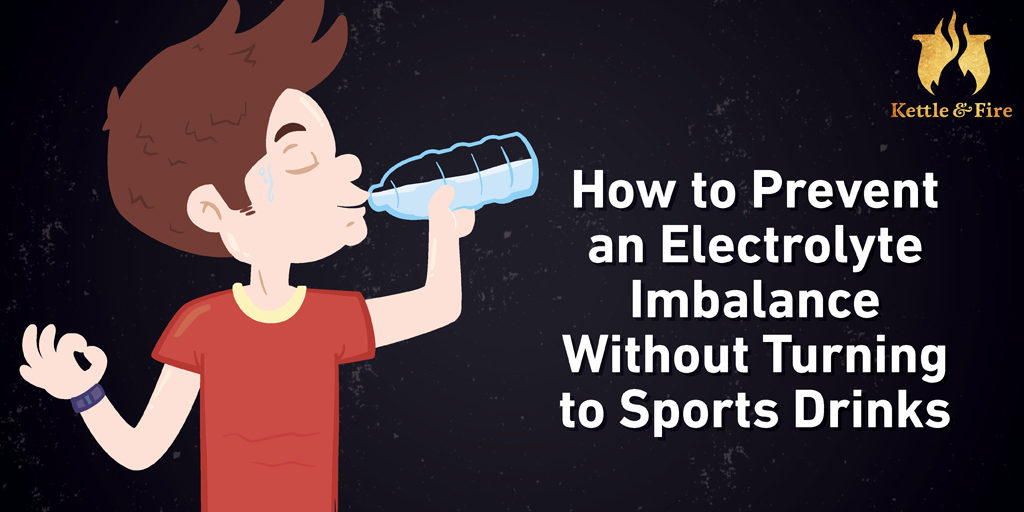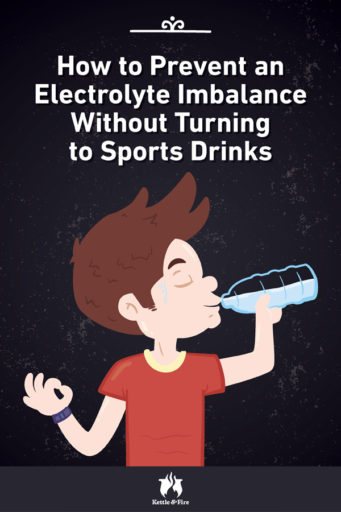How to Prevent an Electrolyte Imbalance Without Turning to Sports Drinks

When you hear the word electrolytes, what do you think of? If you played sports in high school or enjoy catching a game on TV, you probably picture big, bright orange coolers full of neon-tinted beverages being poured over coaches after a big win.
Or something to that effect.
Certain sports drink brands put electrolytes on the map. But while you might write them off as nothing more than clever marketing and expertly-designed packaging, know that the original formulas were completely backed by science.
As you’re about to find out, electrolytes play a vital role many human functions. Below, you’ll learn exactly what electrolytes are, why your body needs them, and excellent sources of electrolytes — more so than you’ll find in a vending machine.
What Exactly Are Electrolytes, Anyway?
Electrolytes produce ions when mixed with water. These ions have a positive or negative charge, creating electricity in the body (1). This enables them to send signals to various parts of your body, helping provide multiple functions related to your brain, nerves, and muscles.
Some of the most well-known electrolytes are sodium, phosphate, potassium, calcium, and magnesium. And while the sports drink industry has profited off their top-secret formulas, it’s actually not that hard to make a sports drink at home. Just sprinkle a little sea salt (sodium) into a glass of coconut water (loaded with potassium), and you can fuel yourself with electrolytes.
While electrolytes have been necessary for human survival since the beginning of time, they gained widespread attention in 1965. The coach for the Florida Gators noticed extreme weight loss and dehydration amongst his players, so he consulted a doctor. The answer, he found, laid in a loss of electrolytes, when your body loses more than water through sweat (2).
The first version of Gatorade (named for the team) was nothing more than sugar water with a dash of salt. The problem? It was disgusting, so they started adding lemon juice and other flavors, eventually evolving into the drinks you’re used to seeing today (2).
Signs That You Have an Electrolyte Imbalance
What happened to Florida athletes back in 1965 was a textbook case of electrolyte imbalance. When you experience an extreme loss of body fluids, whether it be through extreme physical training, vomiting, or even diarrhea, your body loses electrolytes. Other, more rare, causes range from kidney disease, breast cancer, poor diet, eating disorders, and severe dehydration.
When you experience an electrolyte imbalance, you could experience many symptoms easily mistaken for just pure…exhaustion. Muscle cramps, high fever, weakness, dry mouth, and lethargy are common symptoms of an electrolyte imbalance. Therefore, you could think, “Alright, I just need a day off from the gym,” or “I’ve been feeling sick lately, this is just a another side effect,” when really you need to replenish those electrolyte levels.
Mild, benign symptoms of electrolyte imbalance can easily turn into more serious medical condition(s) if you don’t replenish your body with the electrolytes it’s losing. Seizures, convulsions, kidney problems, high blood pressure, an irregular heartbeat, and even heart failure fall under the more serious side of electrolyte disorders (3).
The Best Electrolyte Drinks Should Have These Things
There are many different electrolytes, with each playing a different role in your body. But if you read a nutrition label looking for the word “electrolyte” you will be sorely disappointed. These individual electrolytes, on the other hand, you might recognize (4):
- Sodium: Contrary to what you may have been told, sodium — the same found in sea salt — is actually very beneficial, helping to maintain muscle function and nerve function. Low sodium levels can cause muscle weakness and fatigue.
- Chloride: Chloride helps balance other electrolytes, and helps your body keep a healthy pH level.
- Potassium: If you ever experienced muscle cramping during a sports activity and were told to eat a banana, you know the value of potassium. Keeping your potassium levels in check helps control muscle contraction, thereby preventing muscle spasms.
- Magnesium: Magnesium helps maintain healthy glucose levels and enhances your immune system. It also contributes to muscle and nerve function.
- Calcium: Calcium, as you are probably aware, helps promote healthy bones and teeth, but it also plays a vital role in nerve and muscle movement.
If you’re looking for the best electrolyte drinks, you’ll want it to contain a combination of the above minerals (and not much else). As stated earlier up this post, you can make a very basic recovery drink by sprinkling sea salt in a glass of coconut milk. If you’re looking at a label that contains over 20 ingredients, it’s probably not the best choice.
How to Watch Out for the Worst Electrolyte Drinks
There are many, many drinks that can provide your body with the electrolytes it needs — and frankly, some of the best options don’t advertise that they contain electrolytes at all.
Electrolytes are essential minerals, and it’s not uncommon to find trace minerals in beverages (and foods, for that matter) that you consume on a daily basis. Both tap water and bottled water, for example, contain various forms of electrolytes (5).
Electrolyte Drinks to Avoid
Many sports drinks promoted by big-name brands are best avoided. These drinks contain an unnecessary amount of sugar, harmful ingredients, and artificial coloring. As a general rule of thumb, try to avoid the following:
- Anything with artificial food coloring: If you see “Red 40” or “Yellow 5” listed as an ingredient, you’d be better off setting it back on the shelf, as these artificial colors may cause cancer (6).
- Anything with artificial sweeteners or high amounts of added sugar: Aspartame and other artificial sweeteners can wreak havoc on your health, and are best avoided. Avoid any sports or energy drink with an unnecessary amount of sugar (the Lemon-Lime Gatorade, for example, contains 34 grams of sugar) (7).
- Anything with “natural flavor” or “artificial flavors” listed as an ingredient: The thing about natural flavors is that you never know exactly where they come from. Many of the most well-known sports drinks, including Powerade, Gatorade, Pedialyte, and Propel, are all made with natural flavors.
Easy Ways to Replenish Your Electrolyte Levels
If you are staying properly hydrated, are not experiencing flu-like symptoms, and are not overdoing it in your fitness routine, you shouldn’t fall victim to an electrolyte imbalance. That being said, there are plenty of easy, affordable preventive measures out there:
- Make your own homemade electrolyte drink: Here’s a simple sports drink recipe — sprinkle a dash of himalayan sea salt in regular drinking water or coconut water, and you have a homemade electrolyte water. For a little more flavor, consider adding lime juice, orange juice, raw honey, or 100 percent fruit juice.
- Eat foods high in minerals: Vegetables like bananas, spinach, and other leafy greens, sweet potatoes, yogurt, and lentils are all good sources of electrolytes (7). Avoiding processed foods and eating real foods will keep your electrolyte balance in check.
- Consider electrolyte supplementation: Dietary supplementation can certainly help with electrolyte depletion. Dietary supplements containing minerals like phosphorus, potassium, and sodium could help your electrolyte levels.
- Drink bone broth: Bone broth contains trace minerals including phosphorus, sodium, magnesium, and calcium, making it a rich source of electrolytes.
Sometimes, the Best Sources of Electrolytes Are Unexpected
Electrolytes are a vital many important functions within human body. They balance your pH levels, maintain a healthy heart rhythm, keep your nervous system healthy, are vital to kidney function, and prevent your muscles from cramping up.
While you won’t see the word “electrolyte” on a nutrition label, you can easily search for phosphorus, calcium, magnesium, potassium, and other minerals which also happen to be electrolytes. Beverages such as bone broth, coconut water, and plain water all contain traces of electrolytes. If you experience electrolyte loss and are considering taking electrolyte supplements, you should always speak to a healthcare professional first.
Unfortunately, many big brands that advertise their products as containing electrolytes are some of the worst offenders. So rather than grab a sugar-laden sports drink from the vending machine, drink a mug of bone broth to prevent an electrolyte imbalance.
Pin for later:










